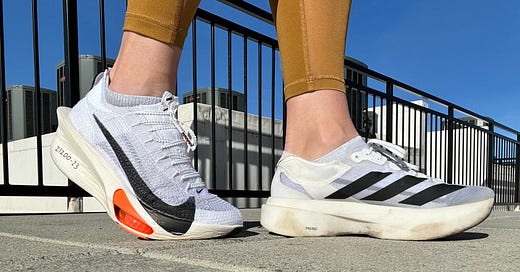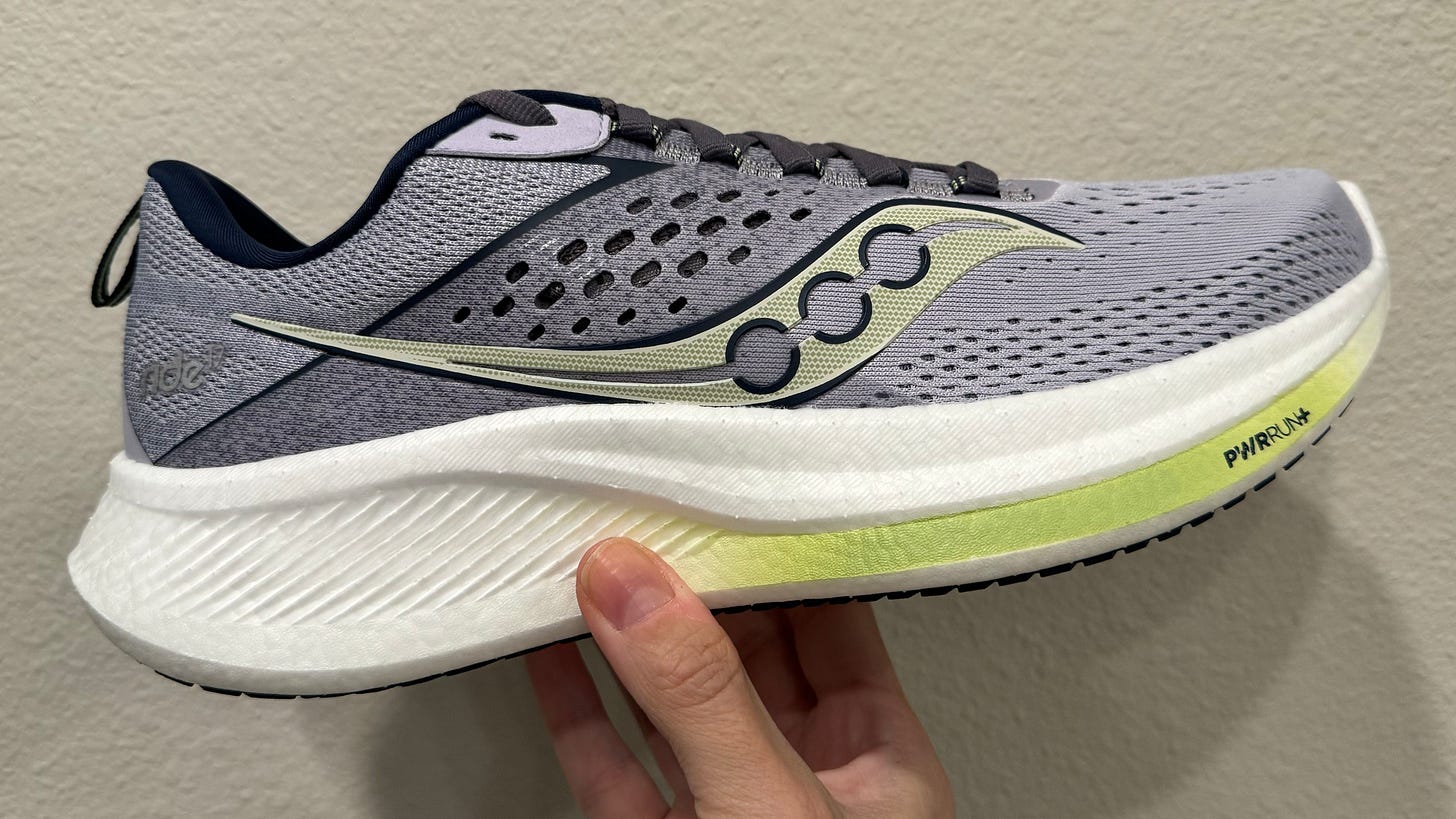The Business of Super Shoes
As exciting as this tech is, it’s likely less popular among (and bringing in less money from) the masses than you might think.
If you were to believe social media, every runner is running in super shoes. (A new Nike Alphafly release is to runners what a Yeezy drop was to sneakerheads before Kanye went off the rails.) These shoes, which combine bouncy lightweight midsole foams with a rigid plate usually made out of carbon, look sexy, seem ubiquitous online and IRL, and have some people claiming their popularity is bringing about “the destruction of running as a sport.”
But is social media actually overexaggerating the role of super shoes in the running world? There’s no doubt they’ve had a massive effect on elite performance, but newer research shows they don’t benefit runners equally, and, while they seem ubiquitous in races, sales reports show they’re less popular among the masses.
The global running shoes market size was worth about $48.4 billion in 2022, and that number is expected to reach $ 74.2 billion by 2031, according to market reports. Super shoes represent a small portion of that value, even with their astronomical prices.
It all started in 2017 with the first super shoe, the Nike Vaporfly 4%. The OG super shoe earned that name because it was shown to improve running economy (at paces between 5:22 and 6:54 per mile) by an average of 4 percent, a 2017 study published in Sports Medicine determined. In the seven years since, nearly every brand has come out with a carbon-plated shoe: ASICS, Brooks, Hoka, New Balance, Puma, Saucony, even brands like TYR all sell carbon-plated shoes.
Brands jumped on the bandwagon, because research shows that super shoes do three things that improve performance, Jamie Langley, a lecturer in exercise physiology at Loughborough College in the UK, told me for a story in Outside magazine: “They improve running economy, which reduces the energetic cost of running, allowing athletes to sustain a higher running velocity; enhance critical speed (i.e. your maximum sustainable steady state) during heavy exercise; and provide enhanced durability through preservation of running economy when muscles are in a damaged state, meaning last few miles of that marathon might not feel as difficult.”
Despite those benefits, the number of pros competing in super shoes, and the prevalence of super shoes on social media, only eight percent of Americans said they knew what super shoes are, according to a 2023 report by manufacturing company ARRIS. Of that eight percent, only 27 percent actually own them—but 100 percent of super shoe owners who have raced wearing their shoes believe they helped their performance.
So, super shoes are not best-sellers (despite the limited availability of, say, the Nike Alphafly 3 on release day would have you believe). Instead, the best-selling and most popular running shoes are generally beginner-friendly daily trainers. In 2023, Brooks held the number one spot in the adult performance running footwear market at U.S. retail for the seventh consecutive quarter, the company reported, with the Brooks Ghost and the Brooks Adrenaline GTS as the company's top two selling shoes at U.S. retail. Brooks was also event participants’ most preferred brand for training and racing footwear, according to the Running USA 2023 Global Running Survey released in 2023. Meanwhile, the Hoka Clifton and Nike Pegasus were the top running shoes overall on Strava in 2023, according to the fitness tracking app’s Year in Sport report, and the Clifton and the ASICS Novablast were the fastest growing shoes over 2022.
One of the big reasons super shoes aren’t more popular from a sales perspective? They’re expensive, mostly due to material and labor costs. The average manufacturer's suggested retail price of a running shoe is $121.10, according to RunRepeat. But the Adidas Evo, with its proprietary new outsole technology and new manufacturing process to reduce the weight of their Lightstrike Pro Foam costs $500; the Saucony Endorphin Elite is $275, the Brooks Hyperion Elite 3 and HOKA Rocket x2 are $250. Then there’s the perceived value: When you see Kelvin Kiptum break the marathon world record while wearing a Nike Alphafly 3, you’re more likely to shell out $285.
The marketing and social media hype is real, and it’s easy for a certain subset of runners to get seduced by the potential to boost their race times. But while seeing athletes break records in super shoes gives the tech and designs credibility and authenticity, it’s harder to translate that into sales compared to other sports—for example, while Nike’s Jordan Brand brought in $5.1 billion in 2022, I’m pretty confident that the brand’s EK Umoja Collection, a capsule of running footwear and apparel inspired by Eliud Kipchoge, didn’t come close to that.
Running shoes are so personalized that what works for a pro or even your training partner might not work for you—it’s almost impossible to make a one-size-fits-all shoe in terms of performance. Study after study shows that the best shoe for your performance is the one you feel most comfortable in.
Going back to that OG Nike Vaporfly study, 4% was the average boost to running economy (at paces between 5:22 and 6:54 per mile); individual results ranged from 1.59 to 6.26 percent. And people running at slower paces will see less of a benefit, research published in 2023 in The International Journal of Sports Physiology and Performance found; those running at an 8:03 mile pace saw a 1.6 percent boost in running economy, while those running at a 9:40 mile pace saw just a 0.9 percent increase.
Because not all super shoes affect runners the same way, we’re seeing brands release carbon-plated daily trainers to broaden their reach. See: the New Balance FuelCell SuperComp Trainer, Saucony Kinvara Pro, and Hoka Mach X). They’re not quite as expensive as racing super shoes, and offer a little more versatility and durability to make them more appealing.
We’re also seeing some brands tweaking designs to suit different paces: For example, Salomon’s S/Lab Phantasm 2 is meant for runners clocking a 3:00 marathon time or faster, but since 96 percent of marathon runners are actually slower than that, the brand is introducing the S/Lab Spectur, which also has a full-length carbon plate but is designed with more support, stability and durability for those who race in the three- to six-hour range.
All of this is to say that while super shoes are likely less pervasive than you might think they are in the larger running community, there’s a lot of potential for that market to grown, and I think we’re going to start seeing more fine-tuning in how they’re used and how they’re designed to support different runners. In the meantime, keep in mind that you may not need or be best-served by a super shoe, no matter how sexy they look on social media, and you should focus on finding the shoe that feels best to you.
the rundown
Saucony Ride 17
I know this shoe is on its 17th iteration, but I’ve actually never run in any previous version. Which, I guess, doesn’t really matter, because the Ride 17 is a top-to-bottom overhaul from Saucony. At TRE, a number of brands talked about leaning hard into the everyday shoe, and this is a great example. It has a completely redesigned cushioning system (it’s PWRRUN+ foam, the same foam you’ll find in the Saucony Triumph) for extra comfort and energy return, and I could really feel that on my first run. It’s light, firm but not too firm, and has 35 millimeters of foam under the heel, giving it an 8 millimeter drop. It’s lower profile than some of my preferred maximally cushioned daily trainers, which is a good thing, because I’m trying to embrace a little less stack height when I can. I was surprised by how much I liked this, and I think it’ll be a regular for easy runs (although Saucony recommends it for uptempo runs, too).
CES’ Coolest Health and Fitness Tech
This annual tech trade show is where tons of health and fitness gadgets are announced each year, and there were a couple of things that caught my interest. Amazfit, a Chinese smart wearable brand, is releasing Helio, a new health-tracking ring (I’m intrigued to see more of this trend); Withings, a French consumer electronics company I mostly know from their smart scales and sleep trackers, will launch BeamO, a Apple Remote-looking device that scans your heart, listens to your lungs, and detects fever for at-home checkups (it can share that info with your doctor); and Baracoda, another smart tech company, debuted an AI mirror for mental health that analyzes your expressions, gestures, and tones and adapts to your mood with light therapy, meditational walkthroughs, and self-affirmations (I’ve covered “modern mood rings” before, but this is a new level).
“Long hours, poor pay, discrimination: Why the number of women in collegiate coaching remains low,” Fast Women
Even if you weren’t a collegiate runner, I would encourage you to read this deep dive by Allison Wade into why women make up such a small percentage of head coaching positions across all NCAA divisions—especially compared to other sports. The main reasons were financial, family-related, or due to a toxic work environment (the old boys’ network and bro culture still reign supreme in college running, apparently). Wade said she spent nearly two years working on this story, and she ended it on a hopeful note, with coaches’ tips on how to retain female coaches, thoughts on how to make the profession sustainable for women, and ways for coaches to help themselves. This is the kind of running journalism I want to see more of, so go support the Fast Women newsletter!
The Best Way to Carry Hydration While You Run
I get this question a lot from newer runners, and it turns out there is a science-backed answer. “Carrying a handheld water bottle, waist belt, or backpack, weighing 1.0 kg [2.2 lbs], during a 60-min run exhibited similar physiological changes,” a 2020 study in the journal Frontiers in Physiology determined. As a result, “runners’ choice may be guided by personal preference,” the authors wrote—personal preference and whatever race rules are in place, because if you plan on carrying water during your race, you better practice using that method during training!







The value of super shoes to the brands is not the cash, it’s the halo effect. Having their shoes associated with big moments in running (on a pro’s foot for a win) and on the feet of the fast friends/tastemakers in the local running scene is marketing in action.
People won’t necessarily buy the super shoe but they will remember which brand the pro/fast friend is wearing and that will subtly influence their purchase process.
Nike has used this in other sports including track and field to great results since early in the life of their company.